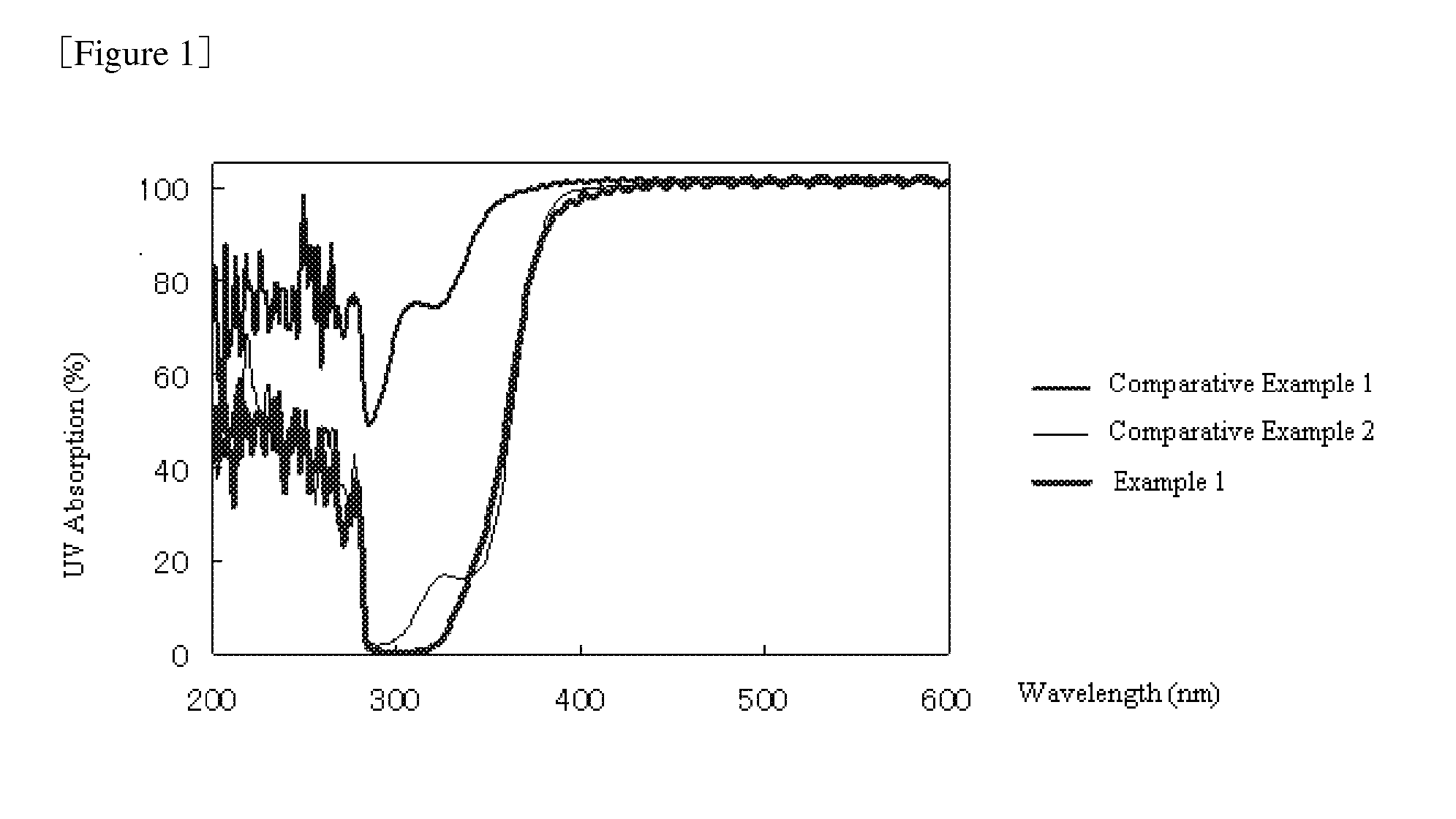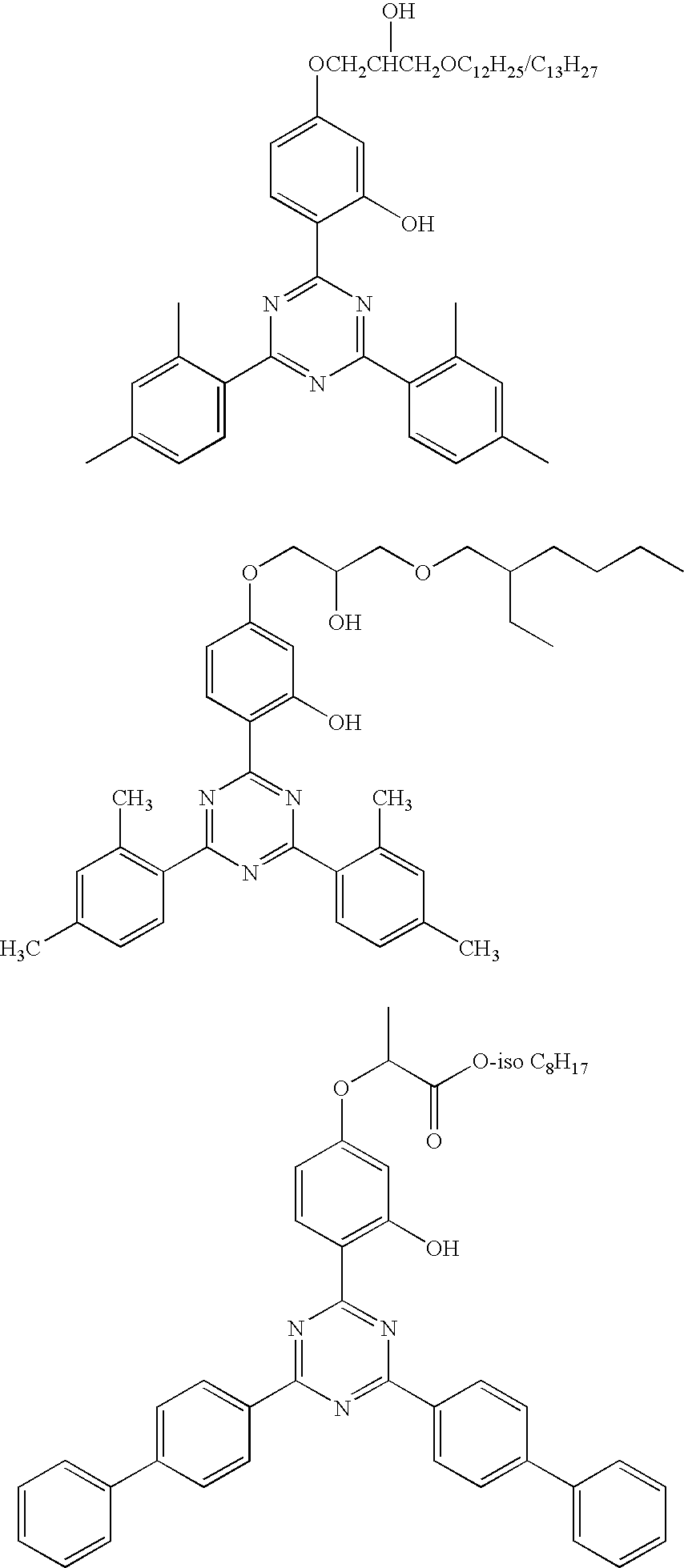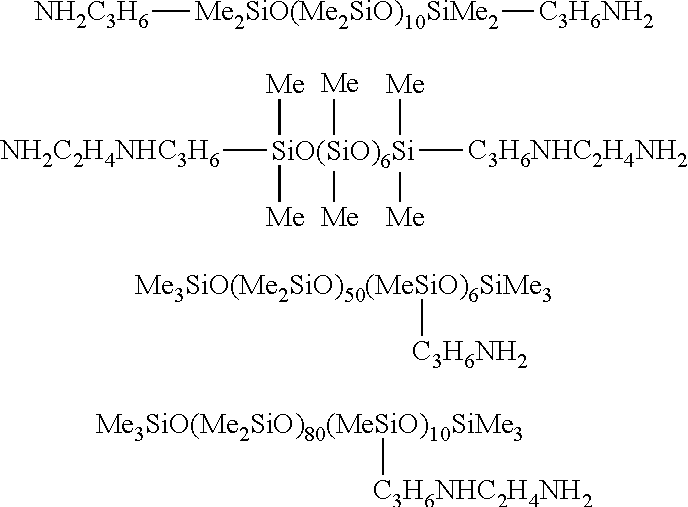Photocurable Resin Composition
a technology of photocurable resin and composition, which is applied in the direction of synthetic resin layered products, textiles and paper, animal housing, etc., can solve the problems of unavoidable degradation of thermoplastic resin, timewise deterioration of the coated substrate itself, and thermoplastic resin composition composed of substrates, etc., to achieve excellent ultraviolet absorbing performance, easy to cure, and excellent storage stability
- Summary
- Abstract
- Description
- Claims
- Application Information
AI Technical Summary
Benefits of technology
Problems solved by technology
Method used
Image
Examples
example 1
[0134]14.2 g methyl ethyl ketone (abbreviated below as MEK), 17.4 g urethane acrylate resin (trade name: KAYARAD UX-5000, from Nippon Kayaku Co., Ltd.), and 0.36 g of a polydimethylsiloxane having 3-aminopropyl at both terminals (BY 16-853U from Dow Corning Toray Co., Ltd.) were introduced into a flask and were stirred for 1 hour while heating at 50° C. Once this had been cooled, 5.78 g 3-methacryloxytrimethoxysilane, 57.8 g of a PGM dispersion of colloidal silica having a concentration of 30 weight % and an average particle size for the colloidal silica of 13 nm, and 0.58 g water were added in the indicated sequence with stirring, after which heating was carried out to 50° C. and stirring was performed for 1 hour. After cooling, the following were added to prepare “ultraviolet-curable composition 1”: 2.10 g 2-methyl-1-[4-(methylthio)phenyl]-2-morpholinopropan-1-one (trade name: IRGACURE 907, from Ciba Specialty Chemicals) as the photopolymerization initiator, 1.0 g of a 1-methoxy-2...
example 2
[0145]Primer 1 was uniformly coated using a spin coater on a 3 mm-thick polycarbonate sheet and the heat-induced radical polymerization of primer-1 was then performed by standing for 2 hours at 120° C. in an oven. This resulted in the formation of a uniform primer layer (the primer layer thickness was approximately 0.7 μm) from primer-1 on the surface of the polycarbonate sheet. The ultraviolet-curable composition 1 of the present invention was then coated on this primer layer by application using a No. 9 Mayer bar onto the 3 mm-thick polycarbonate sheet and drying was carried out for 2 minutes at 120° C. Curing was then performed by exposure to 2000 mJ / cm2 ultraviolet radiation using a UVC-02512S1AA01 from USHIO Inc. (lamp: UVH-0251C-2200 metal halide lamp) to produce a polycarbonate sheet having a primer layer between the substrate and an 8 μm-thick cured film (thin film layer) from ultraviolet-curable composition 1. Table 3 reports the result of the hot water immersion test on th...
examples 3 to 5
[0146]Primer-2 through primer-4 were each uniformly coated using a spin coater on a 3 mm-thick polycarbonate sheet followed by drying for 5 minutes at 120° C. in an oven. A uniform primer layer (the primer layer thickness was approximately 0.7 μm) from the particular primer-2 to primer-4 was then formed on the surface of the polycarbonate sheet by photocuring by exposure to 2000 mJ / cm2 ultraviolet radiation using a UVC-02512S1AA01 from USHIO Inc. (lamp: UVH-0251C-2200 metal halide lamp). The ultraviolet-curable composition 1 of the present invention was then coated on this primer layer by application using a No. 9 Mayer bar onto the 3 mm-thick polycarbonate sheet and drying was carried out for 2 minutes at 120° C. Curing was subsequently performed by exposure to 2000 mJ / cm2 ultraviolet radiation using a UVC-02512S1AA01 from USHIO Inc. (lamp: UVH-0251C-2200 metal halide lamp) to produce a polycarbonate sheet having a primer layer between the substrate and an 8 μm-thick cured film (th...
PUM
| Property | Measurement | Unit |
|---|---|---|
| absorption wavelength | aaaaa | aaaaa |
| absorption wavelength | aaaaa | aaaaa |
| absorption wavelength | aaaaa | aaaaa |
Abstract
Description
Claims
Application Information
 Login to View More
Login to View More - R&D
- Intellectual Property
- Life Sciences
- Materials
- Tech Scout
- Unparalleled Data Quality
- Higher Quality Content
- 60% Fewer Hallucinations
Browse by: Latest US Patents, China's latest patents, Technical Efficacy Thesaurus, Application Domain, Technology Topic, Popular Technical Reports.
© 2025 PatSnap. All rights reserved.Legal|Privacy policy|Modern Slavery Act Transparency Statement|Sitemap|About US| Contact US: help@patsnap.com



